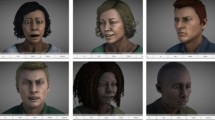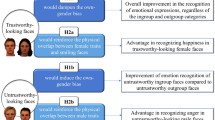Abstract
The present study aims to identify whether individuals’ with a fear of being laughed at (gelotophobia), respond with less facially displayed joy (Duchenne display) generally towards enjoyable emotions or only those eliciting laughter. Forty participants (no vs. gelotophobia) described their feelings to scenarios prototypical for the 16 enjoyable emotions proposed by Ekman (Emotions revealed: recognizing faces and feelings to improve communication and emotional life. Times Books, New York, 2003), while being unobtrusively filmed. Facial responses were coded using the Facial Action Coding System (FACS, Ekman et al. in Facial Action Coding System: a technique for the measurement of facial movement. Consulting Psychologists Press, Palo Alto, 2002). The gelotophobes showed less facial expression of joy compared to the non-gelotophobes (Hypothesis 1) and this effect was stronger for frequency and intensity of Duchenne displays towards laughter-eliciting enjoyable emotions than for no laughter-eliciting enjoyable emotions (Hypothesis 2). Moreover, the no gelotophobia group responded more strongly to laughter-eliciting than to no laughter-eliciting enjoyable emotions. Individuals with marked gelotophobia showed the reverse pattern, displaying less joy in laughter-eliciting emotions which may impact on their social interaction, as communication may break down when positive emotion are not reciprocated.



Similar content being viewed by others
References
Bloch, S., Lemeignan, M., & Aguilera, T. N. (1991). Specific respiratory patterns distinguish among human basic emotions. International Journal of Psychophysiology, 11, 141–154. doi:10.1016/0167-8760(91)90006-J.
de Rivera, J., Possell, L., Verette, J. A., & Weiner, B. (1989). Distinguishing elation, gladness and joy. Journal of Personality and Social Psychology, 57, 1015–1023. doi:10.1037//0022-3514.57.6.1015.
Ekman, P. (1972). Universals and cultural differences in facial expressions of emotion. In J. Cole (Ed.), Nebraska symposium on motivation, 1971 (pp. 207–283). Lincoln, NE: University of Nebraska Press.
Ekman, P. (1994). Strong evidence for universals in facial expressions: A reply to Russell’s mistaken critique. Psychological Bulletin, 115, 268–287. doi:10.1037//0033-2909.115.2.268.
Ekman, P. (2003). Emotions revealed: Recognizing faces and feelings to improve communication and emotional life. New York, NY: Times Books.
Ekman, P., Davidson, R. J., & Friesen, W. V. (1990). The Duchenne smile: Emotional expression and brain physiology II. Journal of Personality and Social Psychology, 58, 342–353. doi:10.1037//0022-3514.58.2.342.
Ekman, P., & Friesen, W. V. (2003). Unmasking the face: A guide to recognizing emotions from facial expressions. Los Altos, CA: Malor Books.
Ekman, P., Friesen, W. V., & Hager, J. C. (2002). Facial Action Coding System: A technique for the measurement of facial movement. Palo Alto, CA: Consulting Psychologists Press.
Ekman, P., Matsumoto, D., & Friesen, W. V. (2005). Facial expression in affective disorders. In P. Ekman & E. L. Rosenberg (Eds.), What the face reveals: Basic and applied studies of spontaneous expression using the Facial Action Coding System (FACS) (2nd ed., pp. 331–342). New York, NY: Oxford University Press.
Fredrickson, B. L. (1998). What good are positive emotions? Review of General Psychology, 2, 300–319. doi:10.1037/1089-2680.2.3.300.
Fredrickson, B. L., & Branigan, C. (2001). Positive emotions. In T. J. Mayne & G. A. Bonnano (Eds.), Emotion: Current issues and future directions (pp. 123–151). New York, NY: Guilford.
Haidt, J. (2003). The moral emotions. In R. J. Davidson, K. R. Scherer, & H. H. Goldsmith (Eds.), Handbook of affective sciences (pp. 852–870). Oxford, UK: Oxford University Press.
Izard, C. E. (1971). The face of emotion. New York, NY: Appleton-Century-Crofts.
Kalawski, J. (2010). Is tenderness a basic emotion? Motivation and Emotion, 34, 158–167. doi:10.1007/s11031-010-9164-y.
Keltner, D., & Bonnano, G. A. (1997). A study of laughter and disassociation: Distinct correlates of laughter and smiling during bereavement. Journal of Personality and Social Psychology, 73, 687–702. doi:10.1037/0022-3514.73.4.687.
Krohne, H., Egloff, B., Kohlmann, C.-W., & Tausch, A. (1996). Investigations with a German version of the Positive and Negative Affect Schedule (PANAS). Diagnostica, 42, 139–156.
Lazarus, R. S. (1991). Progress on a cognitive-motivational-relational theory of emotion. American Psychologist, 46, 819–834. doi:10.1037/0003-066X.46.8.819.
Meehl, P. E. (1975). Hedonic capacity: Some conjectures. Bulletin of the Menninger Clinic, 39, 295–389.
Mortillaro, M., Mehu, M., & Scherer, K. R. (2011). Subtly different positive emotions can be distinguished by their facial expressions. Social Psychological and Personality Science, 2, 262–271.
Panksepp, J. (1998). Affective neuroscience: The foundations of human and animal emotions. New York, NY: Oxford University Press.
Papousek, I., Ruch, W., Freudenthaler, H. H., Kogler, E., Lang, B., & Schulter, G. (2009). Gelotophobia, emotion-related skills and responses to the affective states of others. Personality and Individual Differences, 47, 58–63. doi:10.1016/j.paid.2009.01.047.
Platt, T. (2008). Emotional responses to ridicule and teasing: Should gelotophobes react differently? Humor: International Journal of Humor Research, 21, 105–128. doi:10.1515/HUMOR.2008.005.
Platt, T., Hofmann, J., & Ruch, W. (2011). The 16 Pleasurable Emotion Interview Task (16-PEIT). Unpublished research instrument, Department of Psychology, University of Zurich, Switzerland.
Platt, T., & Ruch, W. (2009). The emotions of gelotophobes: Shameful, fearful, and joyless? Humor: International Journal of Humor Research, 22, 91–110. doi:10.1515/HUMR.2009.005.
Proyer, R. T., Ruch, W., & Chen, G.-H. (2012). Gelotophobia: Life satisfaction and happiness across cultures. Humor: International Journal of Humor Research, 25, 23–40. doi:10.1515/humor-2012-0002.
Ruch, W. (1993). Exhilaration and humor. In M. Lewis & J. M. Haviland (Eds.), The handbook of emotions (pp. 605–616). New York, NY: Guilford Publications.
Ruch, W. (2004). Gelotophobia: A useful new concept? IPSR Spring 2004 Colloquium Series. Berkeley, USA: Department of Psychology, University of California at Berkeley.
Ruch, W., Altfreder, O., & Proyer, R. T. (2009a). How do gelotophobes interpret laughter in ambiguous situations? An experimental validation of the concept. Humor: International Journal of Humor Research, 22, 63–89. doi:10.1515/HUMR.2009.004.
Ruch, W., Beermann, U., & Proyer, R. T. (2009b). Investigating the humor of gelotophobes: Does feeling ridiculous equal being humorless? Humor: International Journal of Humor Research, 22, 111–143. doi:10.1515/HUMR.2009.006.
Ruch, W., & Ekman, P. (2001). The expressive pattern of laughter. In A. W. Kaszniak (Ed.), Emotion, qualia, and consciousness (pp. 426–443). Tokyo, Japan: Word Scientific Publisher.
Ruch, W., & Köhler, G. (2007). A temperamental approach to humor. In W. Ruch (Ed.), The sense of humor: Explorations of a personality characteristic (pp. 203–228). Berlin, Germany: Mouton de Gruyter.
Ruch, W., Köhler, G., & van Thriel, C. (1997). To be in good or bad humour: Construction of the state form of the State-Trait-Cheerfulness-Inventory—STCI. Personality and Individual Differences, 22, 477–491. doi:10.1016/S0191-8869(96)00231-0.
Ruch, W., & Proyer, R. T. (2008a). The fear of being laughed at: Individual and group differences in gelotophobia. Humor: International Journal of Humor Research, 21, 47–67. doi:10.1515/HUMOR.2008.002.
Ruch, W., & Proyer, R. T. (2008b). Who is gelotophobic? Assessment criteria for the fear of being laughed at. Swiss Journal of Psychology, 67, 19–27. doi:10.1024/1421-0185.67.1.19.
Ruch, W., & Proyer, R. T. (2009). Extending the study of gelotophobia: On gelotophiles and katagelasticists. Humor: International Journal of Humor Research, 22, 183–212. doi:10.1515/HUMR.2009.009.
Samson, A. C., Proyer, R. T., Ceschi, G., Pedrini, P. P., & Ruch, W. (2011). The fear of being laughed at in Switzerland. Regional differences and the role of positive psychology. Swiss Journal of Psychology, 70, 53–62. doi:10.1024/1421-0185/a000039.
Shiota, M. N., Campos, B., Keltner, D., & Hertenstein, M. J. (2004). Positive emotion and the regulation of interpersonal relationships. In P. Philippot & R. S. Feldman (Eds.), The regulation of emotion (pp. 127–156). Mahwah, NJ: Lawrence Erlbaum.
Shiota, M. N., Keltner, D., & John, O. P. (2006). Positive emotion dispositions differentially associated with Big Five personality and attachment style. The Journal of Positive Psychology, 1, 61–71. doi:10.1080/17439760500510833.
Titze, M. (2009). Gelotophobia: The fear of being laughed at. Humor: International Journal of Humor Research, 21, 27–48. doi:10.1515/HUMR.2009.002.
Acknowledgments
This article was written thanks to the support of the research grant 100014_126967 given to Willibald Ruch and René T. Proyer by the Swiss National Science Foundation. The authors would like to thank Fabian Gander and Tobias Wyss for their valuable contribution to the data collection. We would also like to acknowledge the work of the Zurich Interaction and Expression Lab team for their help processing the video materials.
Author information
Authors and Affiliations
Corresponding author
Rights and permissions
About this article
Cite this article
Platt, T., Hofmann, J., Ruch, W. et al. Duchenne display responses towards sixteen enjoyable emotions: Individual differences between no and fear of being laughed at. Motiv Emot 37, 776–786 (2013). https://doi.org/10.1007/s11031-013-9342-9
Published:
Issue Date:
DOI: https://doi.org/10.1007/s11031-013-9342-9




